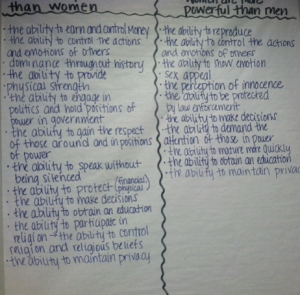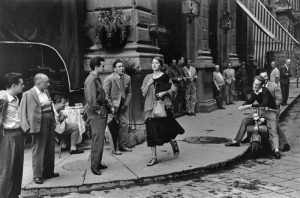Arguments of Judgment—Gender and Power
The following activities took several weeks at the beginning of the academic year. The texts used become increasingly complex. The activities are designed to build strategies for recognizing theme and building arguments with textual evidence to support students’ interpretive claims.
Developing Criteria
 Students can brainstorm a list of criteria from what they have experienced or observed as related to gender and power in their own lives (e.g., the ability to make decisions in the house, the ability to sexually attract, the ability to make and spend money). These criteria should be kept as a public list in the classroom so they are easily accessible as students construct arguments of judgment around gender and power. The same criteria can be used to construct arguments of judgment with increasingly complex texts.
Students can brainstorm a list of criteria from what they have experienced or observed as related to gender and power in their own lives (e.g., the ability to make decisions in the house, the ability to sexually attract, the ability to make and spend money). These criteria should be kept as a public list in the classroom so they are easily accessible as students construct arguments of judgment around gender and power. The same criteria can be used to construct arguments of judgment with increasingly complex texts. ![]()
An American Girl in Italy
Students can then look at various images that depict people who may or may not be in power and for whom gender may play a role in that power. One example may be the photograph “An American Girl in Italy.” (See photograph below.)
This question of whether or not the woman in this image is in power can be discussed as a whole class or in smaller groups. Then the students can decide which evidence might be the most important to support their claims. Following that, an argument paragraph can be developed. ![]()
“Linoleum Roses”
Students can read this short vignette and discuss either as a whole class or in small groups the themes of power and gender. Again, it is important that the selection of evidence and criteria be discussed so that students can compose argument paragraphs. A sample of these paragraphs can be analyzed as a whole class as to build understanding of and strategies for developing argument structure.
“Desiree’s Baby”
This short story, which is more complex than any of the above texts, can be read and annotated by students individually. Then, it can be discussed as a whole class. Then students can select evidence and develop an argument paragraph in small groups. This can be followed by peer analysis of the argument paragraphs. ![]()
